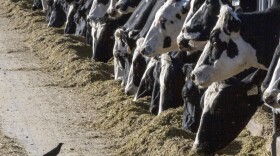-
Cottonseeds could help reduce hunger and add new revenue for farmers. One researcher has been working for decades to make edible seeds a reality.
-
The beef processing plant in Olathe, Kansas, marked a turning point for Walmart. But ranchers and agricultural experts warn the nation's already stunted beef industry could be falling under more corporate control.
-
Collard greens are a nutritious vegetable with a rich cultural heritage in the U.S. Now, scientists and enthusiasts are working to preserve and popularize heirloom varieties that could be tastier and more climate resilient than common grocery greens.
-
Tyson Foods said its ground beef and value-added marinated protein plant would be shuttered in February 2025 to help the company operate more efficiently.
-
The USDA has confirmed 126 cases of bird flu in dairy cattle herds in a dozen states, and three dairy farmworkers have contracted the disease this year. Now Kansas is one of four states participating in a pilot program to test bulk milk tanks on dairy farms.
-
The Supplemental Nutrition Assistance Program — the food program for low-income individuals — has become one of the hottest topics in farm bill negotiations, as congressional Republicans seek more changes.
-
Livestock in Texas, Kansas and Michigan are confirmed to have the virus, and herds in New Mexico and Idaho have also tested positive. Officials confirmed that one person in Texas also had bird flu.
-
This year, wildfires have already burned thousands of acres in the Great Plains. Dry conditions and unseasonably warm temperatures have optimal settings for wildfires, and some experts say they are seeing more intense fires.
-
Aging farmers and fewer farms in the new agriculture census should be a 'wake up call,' says VilsackThe average farmer in the U.S. is now 58 years old, according to the Census of Agriculture, released Tuesday. There are also fewer farms in the country than there were in the last census.
-
At least 21 states are considering legislation to block foreign companies and individuals from purchasing farmland. The issue has gained momentum in recent years.
-
Congress kicked the can down the road by failing to negotiate a new farm bill last year. The bill has been extended through the end of September, but experts say it won't be easy for lawmakers to approve a new plan.
-
The United States has imported $20 billion more in agricultural products than it exported — putting the sector on pace to run a record deficit. A look at what’s behind the numbers.













